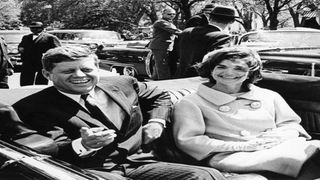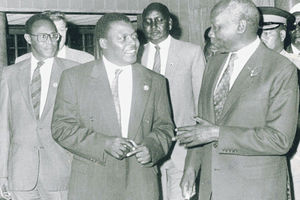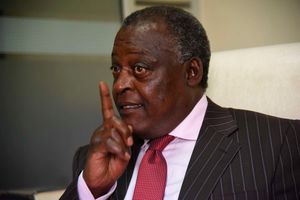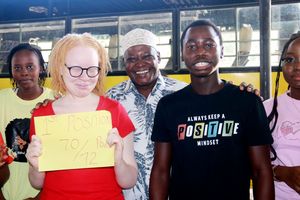
President John F. Kennedy and First lady Jackie Kennedy in Washington, May 3, 1961.
| File | Nation Media GroupWeekly Review
Premium
John F Kennedy@60: One day in United States of America
What you need to know:
- Tom Mboya’s vision and Kennedy’s mission had brought them together.
- President Kennedy argued that African nationalism was being mishandled.
On July 26, 1960, Tom Mboya stood beside John F. Kennedy, then US Democratic presidential nominee, for a press conference in Hyannis Port, Massachusetts. By then, Mboya was the general secretary of the Kenya Federation of Labour and one of the most promising leaders in Africa.
For two hours, as the media waited outside, Mboya and Kennedy discussed African politics. Mboya, as it later emerged, was seeking expanded aid to African students who were to join several American universities and colleges. By then, there was no university in the Kenya Colony, and educational opportunity was limited by British colonial mischief.
JFK had moved to the White House with much promise for Africa. He had consistently accused President Dwight Eisenhower of neglecting “the needs and aspirations of African people” and “losing the contest over the Third World”. It was a clear race. Kennedy, 43, won. But on November 22, 1963, while riding in an open motorcade during an official visit to Dallas, Texas, he was shot dead. It was the end of an era of a man who had promised so much for Africa and whose admiration for Kenya’s Tom Mboya and other African nationalists was widely known.
Mboya’s vision and Kennedy’s mission had brought them together. The Kenyan trade unionists – assassinated in 1969 – was fundraising for students to join US universities at a time when JFK was also campaigning for a larger American presence in Africa.
When the State Department refused funds to transport the Kenyan students to the US, Kennedy arranged for the Joseph Kennedy Foundation to pay the $100,000 cost. It has been claimed that Kennedy was seeking to appeal to African liberals and blacks and that he saw Africa as the best platform to gain in the Cold War. “We cannot simply sit by and watch on the sidelines. There are no sidelines. Under the law of physics, in order to maintain the same relative position to a moving body, one cannot stand still,” Kennedy explained in a speech on Africa.
Kennedy argued that African nationalism was being mishandled and that President Eisenhower was failing to support Africa’s desire to end White supremacy and European domination. He had identified himself with African nationalists and chastised the Republicans for alienating emerging African leaders. As he told his campaign, “The sweep of nationalism is the most potent factor in foreign affairs today”.
To him, Africa would become an arena of significant Cold War rivalry, and the US could not be left behind. While Eisenhower had rarely invited African nationalists to the White House, Kennedy had opened his doors: 11 in 1961, 10 in 1962, and seven in 1963.
It was William X. Scheinman who had introduced Tom Mboya to JFK and other American political figures. The two first met in 1956. Scheinman, who served on the executive board of the American Committee on Africa, later helped establish the African American Students Foundation, which took hundreds of Kenyans to study at American universities from 1957 to 1961. He was so close to Mboya that the Kenyan politician was the best man at Scheinman’s second marriage. When he died in July 1999, his ashes were taken to Rusinga Island and buried next to Mboya.
The British government had opposed Mboya’s efforts to send talented young Kenyans to the United States for an education, arguing that there was a perfect university at Makerere. The US State Department had sided with Britain, and Mboya turned to private foundations.
That is when Jackie Robinson, Harry Belafonte, and Frank Montero set up the African American Students Committee (it later became a foundation) to solicit funds to pay for transportation. Mboya had also written to his friends, asking them to accommodate the students. He was then introduced to JFK.
Besides the airlift, which created a pool of US-trained elites, Kennedy would significantly impact Kenya through the Peace Corps program, in which hundreds of Americans were sent to Africa as part of the US entrenchment of its foreign policy. They came as teachers, nurses, doctors, and engineers and were dispatched to rural districts. They would form a secure policy link between Kenya and the US – a big political score for JFK.
Interestingly, it is claimed that the Peace Corps idea was given to Kennedy by another presidential aspirant, Sen Hubert Humphrey, who had withdrawn from the race. It was during an October 1960 campaign appearance, four months after he received the ‘Peace Corps’ package, that Kennedy asked the University of Michigan students: “How many of you who are going to be doctors are willing to spend your days in Ghana… how many of you are willing to work in the foreign service and spend your lives travelling around the world?” Next month, JFK proposed launching Peace Corps to counter a similar Soviet programme. The US program would send volunteers for 18 months.
After Kennedy won the presidency, he started fulfilling his campaign promise about Africa by sending a team to study US African policy. That report recommended “sweeping changes in America’s attitude towards Africa”. It also asked the US to “abandon its traditional fence-sitting… in favor of support for African nationalism”. He started by giving prominent Africanists some senior positions in his administration, starting with Mennen Williams, appointed assistant secretary of state for African Affairs.
Kennedy described Williams’s post as a “position of responsibility second to none in the new administration”. When Williams made the controversial statement: “What we want for the African is what the Africans want for themselves,” which was misreported that the US wanted “Africa for the Africans”, Kennedy stood by the diplomat, arguing that “Africa for the Africans… (was not) unreasonable statement… I do not know who else Africa should be for.”
While Williams was unpopular with white settlers in South Africa and then Rhodesia, he was popular among the black nationalists and the Kennedy administration. It was during the Kennedy administration that the likes of William Atwood, the man who later fell out with the Kenyatta government over his book The Reds and Blacks, would take diplomatic duties in Guinea.
Africa was the playground of the US and Soviet interests. From Washington, just before Kennedy took power, President Eisenhower had ordered the elimination of Congo’s leading pan-Africanist, Patrice Lumumba. Records from the president’s minute-taker revealed 23 years ago that Eisenhower had ordered the director of CIA, Allen Dulles, “in the full hearing of all those in attendance and saying something to the effect that Lumumba should be eliminated”. Lumumba, the first prime minister of Congo after its independence from Belgium in June 1960, was out and captured by his nemesis. He was assassinated on January 17, 1961. While the CIA may have plotted the elimination, it was the Belgians who are today accused of aiding the assassination.
His major triumph was to get various African nationalists – who were openly pro-western – run Cold War neutral campaigns. This group was led by Mboya and was opposed to the John Forster Dulles principle that regarded neutralism as “transitional stage to communism”. While Dulles had described Africa’s neutrality as “an obsolete … immoral and short-sighted conception”, Mboya had mesmerised Kennedy by eloquently stating that African states were “neither pro-Moscow nor pro-Western, they are pro-African”.
As Kennedy would later remark: “To dismiss or denounce these men (Third World nationalists) for every foolish thing they said or did, to cut off our aid food shipments every time they aroused our displeasure … would only play into the hands of the Communists.”
But at the very end of his life, some scholars claim that JFK had “began to realise that the courting of African nationalist leaders was more complicated than he had originally anticipated”. While he had been warned against making strong aid ties with “shaky neutralists” such as Egypt, Ghana, Guinea, and Tanganyika, Kennedy thought it was a wise investment since these states could give the US diplomatic support at the UN.
Kennedy was right, and Kwame Nkrumah, Abdel Nasser, and Sekou Touré denied Moscow access to their airfields during the Cuban missile crisis. It was these leaders who helped the US shape its foreign policy towards Africa, and Kennedy – more than any other US president had much respect for African nationalists. When he was shot dead, Africa mourned. Sixty years later, his legacy lives on.
[email protected] @johnkamau1





